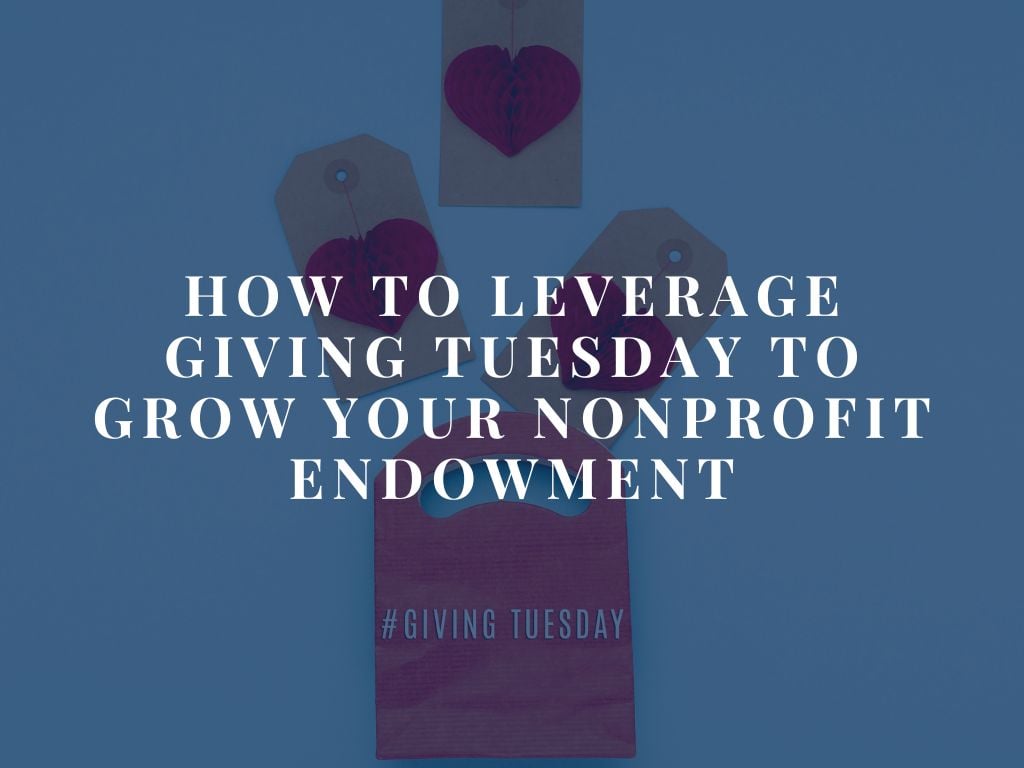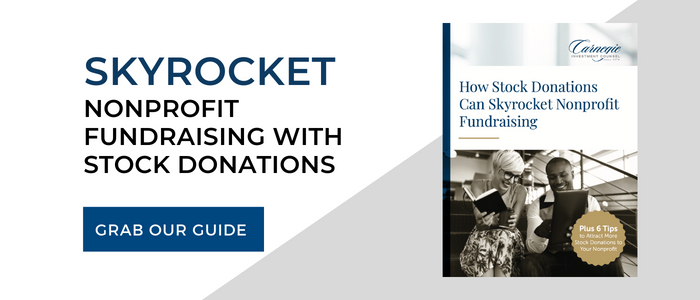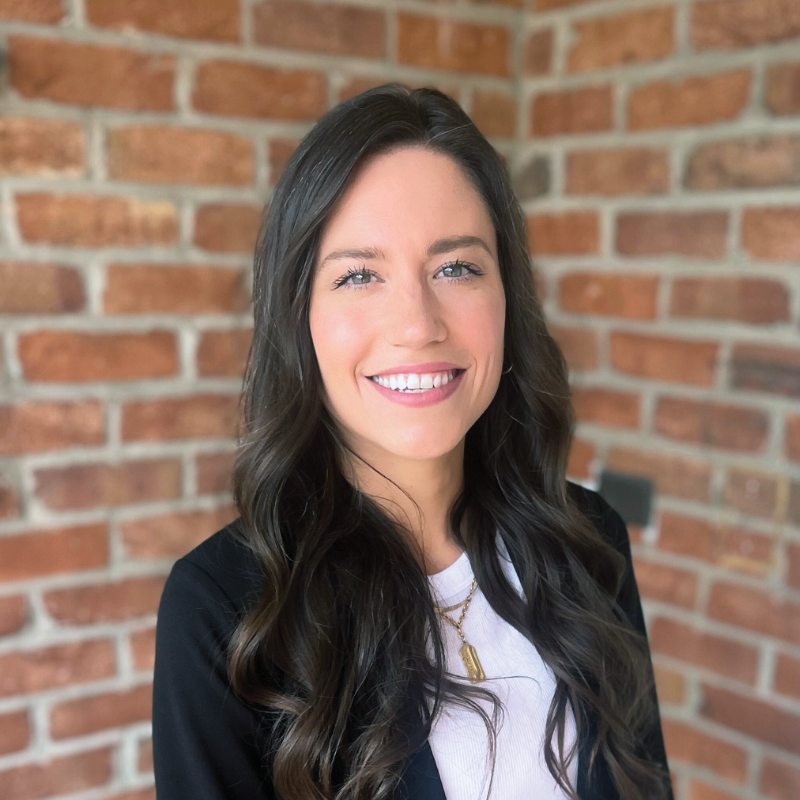
Growing your nonprofit endowment is important for the long-term success of your organization. By providing sustainable funding, an endowment allows you to spend less time worrying about finances and more time accomplishing your mission.
Many organizations make the mistake of not utilizing their current fundraising campaigns to increase their nonprofit investment. Every special event, giving day, and year-end appeal should be used as a chance to increase the impact of your endowment.
Giving Tuesday is a great opportunity to educate and inspire your donors. They need to know they have the opportunity to give a gift now that will live on into perpetuity. No need to do all the work of a special endowment campaign! Here are a few tactics you can use to leverage Giving Tuesday to promote your nonprofit endowment.
Be Clear on What These Funds Are Supporting
“Supporting our mission” is not a sufficient answer. Donors are smarter and more invested in their philanthropy than ever before, and they want to know exactly where their donation is going. Be specific about what the funds you raise on Giving Tuesday will support. Sharing stories that highlight the importance of that specific program or part of your mission will help you connect with donors.
You may choose to direct all funds raised on Giving Tuesday to your endowment. Van Wert Civic Theatre did this in 2020 and created urgency and excitement by adding a matching donor. If you don’t want to monopolize the donations, you can incorporate the option to make a contribution into the endowment fund in your existing marketing materials and asks.
Having a well-written spending policy statement makes communicating endowment impact easier. With a clear vision into the future, you can ensure donors that you have a responsible plan in place to utilize and grow their donation. Carnegie offers help for foundations and nonprofits who are establishing spending policy statements and don’t know where to start. If you are looking for financial guidance for your nonprofit, you can book an appointment today.
Gather and Share Your Impact
To cultivate donations, you should also know how your endowment has already helped your organization and the mission you serve. Often funds generated from endowments fill gaps the organization would otherwise have had to cut, such as an unfunded program or staff position. Share with your donors all the good you were able to accomplish that would not have been possible without gifts to your endowment.
Countless studies have shown that a heartfelt story will attract more donations than sharing statistics. Make sure to have a few notable successes that directly resulted from your nonprofit endowment. Communicate these stories with donors everywhere a donor comes in contact with your organization. Focus on who or what these funds support and what would have been the consequence if these funds didn’t exist.
Your nonprofit investment manager should be able to give you reports, insight, and projections into the performance of your fund. Then work with your organization’s program managers to recruit specific stories and gather testimonials so you can share an all-around picture of your endowment fund’s impact and performance.
Identify and Segment Current Donors
Chances are, you have several donors in your donor management system who are ripe with opportunity for a major gift towards your endowment. Look for donors who have:
- Made consistent donations for the last five years
- Given multiple times in a year
- Donor Advised Funds (DAF)
- Engaged with your nonprofit more than usual
These donors already love your organization and your mission, and they want to see you grow and prosper for many years. Don’t forget about looking at your volunteers!
Segment and engage these donors, let them know you have an endowment fund and share how it has helped the mission you serve. Communicate how important your endowment fund has been and what your organization plans to do with the funds in the future. Share several stories that showcase the impact your endowment has made and who or what it supports. Engage one on one with them and let them know your goal for your endowment on Giving Tuesday. Donors love to be part of accomplishing a shared goal.
Start Communicating Early
Donors are inundated with requests for donations throughout the year, but it is especially intense during Giving Tuesday. You are competing with almost every nonprofit, all trying to capitalize on the giving season. That is why it is critical to begin communicating your impact early and often.
You want to ensure four to five soft touchpoints before asking for a donation on Giving Tuesday. Soft touchpoints occur anytime you engage with a donor without making an ask. Focus on what makes your organization unique and the impact you make on your mission and community.
Start by sending an impact update to all donors from last year, four months before Giving Tuesday. In September, begin cultivating current donors, sending teasers or a save the date, and sharing program success stories or updates across all your platforms.
Continue communicating with your donors leading up to the event. Use photo, video, graphics, email copy, social media, direct mail, marketing partnerships, and more. Your goal is to share impact and ways to participate in the giving day as soon and as often as possible!
Have a Process for Accepting Non-cash Assets
Giving the option to donate non-cash assets can open up your organization to many potential gifts. These assets can often support your nonprofit endowment and make a greater impact for years to come. Make it known that these are available gift options by listing them everywhere you include an ask. Non-cash assets encompass many options, to name a few:
- Bequests
- Unneeded required minimum distributions (RMD)
- Life insurance annuities
- Highly appreciated securities
- Cryptocurrency
Your organization should have a documented process for donating non-cash assets that is easy and clear for the donor. Working with your nonprofit investment manager is the best way to ensure proper legal requirements, best practices are followed, and an efficient and smooth process for both the donor and the nonprofit.
It can be confusing and frustrating to facilitate a donation of non-cash assets. Contact Carnegie today to speak with an advisor about options to accept these unique assets.
Make It Easy and Noticeable
Attention spans and patience are dwindling. It’s important to ensure the donation process is quick and easy for your donor and meets their unique giving and communication needs. List “Contribute to Endowment Fund” and all non-cash assets accepted as options everywhere you ask for a gift, including your Giving Tuesday landing page, general donate page on your website, remit envelope, emails, in-person asks, at fundraising and community events, etc. You can even add it to your team’s email signature with links. Many donors do not know about this option and will be excited to hear about it, so put it everywhere and say it often!
Ensure your website is optimized to track these unique donations and use a clear call to action in all marketing copy. The Boston Foundation does a great job of showcasing the power of non-cash gifts. Make use of banners and landing pages to promote gifts to your endowment and target specific donors.
Cultivate New Donors for Future Gifts
According to Classy, Giving Tuesday brings in an incredible number of new donors. Luckily for you, these donors are more likely to engage in different campaigns over the next year than donors acquired via other events. Spending the next few months stewarding these donors will allow you to build a relationship that may lead to a gift towards your endowment.
Take some time after Giving Tuesday to thank, research, and cultivate new donors. Introduce them to your organization, send them your welcome email sequence, and find out how they heard about the organization. Use wealth screening and giving history tools like WealthEngine or DonorSearch to identify donors with high capacities to give.
Steward these new donors over the coming months and continue engaging with them to find out why they give and what draws them to your mission. This knowledge and relationship can eventually turn into a major gift for your nonprofit endowment!
Leveraging Giving Tuesday Is a Great Way to Promote Your Nonprofit Endowment
Leveraging Giving Tuesday is a great way to promote your nonprofit endowment. Utilize clear communication, share impact stories, and work with your nonprofit investment manager to create easy processes. Your donors will enjoy giving a gift that makes an impact for generations to come!
How Can a Nonprofit Investment Manager Help Your Endowment?
At Carnegie, we understand you have a lot on your plate. You and your team wear a lot of hats, while financial resources are always in demand. Managing the finances of a nonprofit can be tedious and stressful. A financial advisor at Carnegie Investment Counsel can help lighten your workload by being a financial and investment guide to your organization.
We come alongside you as a fiduciary to manage your assets with a long-view approach. Having an active investment team dedicated to your endowment can make a meaningful impact on your nonprofit's sustainability, meet your programmatic needs, and help you achieve your mission.
From Investment Policy Statement (IPS) creation to non-cash asset assistance, to implementation and reporting - we'll guide you through each step. Contact Carnegie today to speak with an advisor about your organization's investing and endowment management needs.
Looking for a Financial Advisor for Your Nonprofit?
If you are currently looking for help with financial planning, contact us. We are happy to schedule an introductory meeting at your convenience.



